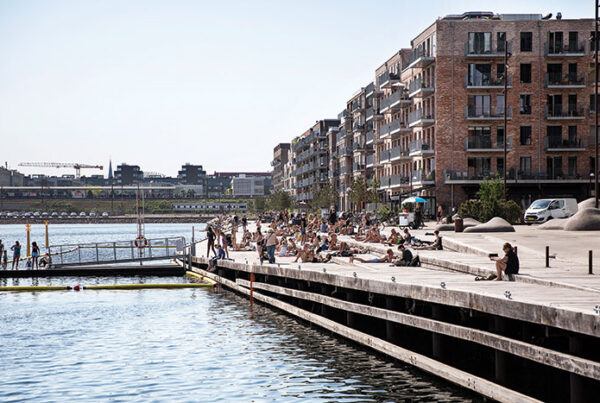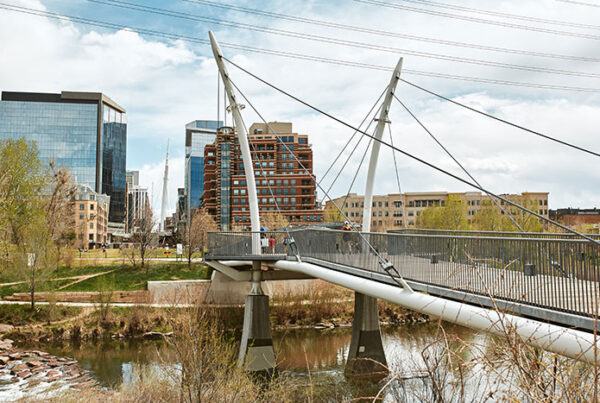The year 2020 was one of deep tragedy and uncertainty. It also marked the first year in a pivotal decade for the real estate industry in making the transition to a low-carbon future. In fact, investment in and achievement of environmental, social, and governance (ESG) goals surged last year, according to State of Green: ULI Greenprint Performance Report, Volume 12, an annual benchmark report just released by the ULI Greenprint Center for Building Performance.
The report presents the most recent snapshot of best practices and progress toward long-term goals from a growing network of leading real estate owners and developers. In 2020, the collective Greenprint community of 47 companies grew to include nearly 12,000 properties in 30 countries, up from just over 10,000 properties in 2019.
The global annual benchmark report also serves as a point of reference and inspiration for the industry, showing how companies are pushing forward to develop green buildings and decarbonize the built environment. This past year proved no different:
- The COVID-19 pandemic did not slow progress on sustainability indicators; in fact, carbon emissions from Greenprint properties dropped a record 12.4 percent in 2020 from a year earlier.
- Leading global real estate companies are prioritizing sustainability in how they invest and how they operate their assets, with strong financial, social, and environmental returns; Greenprint members reported engaging in 14,000 ESG projects in 2020.
- Recognizing the importance of reducing emissions as part of an ESG strategy, an increasing number of companies have taken up the ULI Greenprint challenge to achieve net-zero carbon operations by 2050, covering over $570 billion in assets under management to date.
Hear more about ULI’s work on ESG at the 2021 ULI Fall Meeting.
Broad Gains on Sustainability
In 2020, the Greenprint portfolio saw significantly larger reductions than usual in all sustainability indicators, with record cuts in carbon emissions, energy use, water use, and waste sent to landfills. Compared with typical cuts of 1 to 3 percent annually, the Greenprint portfolio achieved the following reductions in 2020 from 2019:
- Carbon emissions—12.4 percent;
- Energy use—12.5 percent;
- Water use—8.1 percent; and
- Landfill waste—11.7 percent.
These improvements are likely due, in part, to the impact stay-at-home orders had on commercial building occupancy.
Though median energy use in Greenprint member offices fell by more than 25 percent in some cities, drops in energy use in both Greenprint properties and the broader market were not as sizable as would be expected. In New York City, for example, office occupancy at the depth of the pandemic plummeted to just 5 percent, but energy use in city office buildings did not drop to the same extent, as buildings kept systems running. Greenprint office buildings reduced energy use by only 17.8 percent.
Also, with more people working from home, many predicted that energy use and carbon emissions would rise at multifamily properties, but the number of residents who left major metropolitan areas may have helped keep that from happening. In fact, energy use in Greenprint multifamily properties fell slightly—by just under 3 percent.
It is unlikely, however, that historically low occupancy and stay-at-home orders can explain the larger across-the-board decreases completely. Greenprint members implemented a record number of ESG projects during 2020, driving reductions in carbon emissions, energy and water use, and landfill waste across the portfolio.
“The COVID-19 pandemic revealed the remarkable potential we have to adapt, innovate, and come together to support the measures necessary to create a better tomorrow,” says Ben Myers, vice president, sustainability, at Boston Properties. “We will continue to demonstrate our commitment and capacity to conduct our business in a manner that contributes to positive economic, social, and environmental outcomes for our customers, shareholders, employees, and the communities we serve.”
Increasing Commitment to Net Zero
During 2020, the number of pledges by corporations, cities, and countries to achieve net-zero carbon emissions by 2050 grew considerably. Greenprint was no exception, launching a goal last year of net-zero carbon operations by 2050. To date, 17 companies—including Heitman, which has an accelerated net-zero goal year of 2030—have signed on, comprising over 709 million square feet (65 million sq m) of space, and over 3,300 properties across 20 countries.
As the Paris Agreement lays out, commitments to net zero are critical to ensuring that global warming is kept below 1.5 degrees Celsius and runaway climate change avoided. As the 2020 wildfire and hurricane season demonstrated with tragic clarity, climate risks are intensifying in frequency and severity, and rapidly reducing emissions is the only way to ensure that the real estate industry—and society at large—have a viable path forward.
A Transformative Year
The past year reshaped the urban landscape, creating opportunity for sustainability.
Nevertheless, now is not the time for the industry to let up on the pressure or a sense of urgency. The need for climate action has never been greater, and there has never been such a wealth of resources to support the industry in taking that action. Heitman is honored to be part of this important effort to build a sustainable, low-carbon future. We welcome any and all companies to join us to ensure that, even when confronted with challenges on the scale of a global pandemic and rising climate risk, the rest of this decade continues to build on the progress made in 2020.




